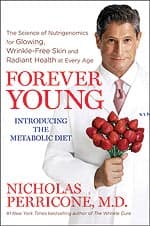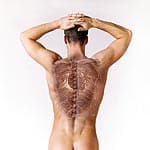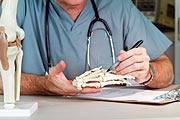Life Extension Magazine®
The health of our bones is instrumental to our health and longevity in general. This understanding is especially important today, because there are so many toxins and contaminants in the environment and food chain. Keeping our bones and GI tract healthy is the first step to maintaining a healthy immune system, which is vital in protecting us from the epidemics and pandemics that seem to be lurking around every corner. Red and white blood cell production alone makes maintaining optimal bone health an important requirement for optimal overall health, especially as we age. It is no coincidence that with aging, diminishing bone health is also accompanied by reduced energy, increased fatigue, an increase in digestive problems, and an increase in maladies associated with a weakening immune system. These maladies include such disorders as rheumatoid arthritis, osteoarthritis, irritable and inflammatory bowel disorders, and a host of other chronic inflammatory and degenerative problems—another excellent reason to make sure your diet is rich in high-quality probiotics and foods that are not pro-inflammatory, since pro-inflammatory foods will compound these problems. Bone cells and immune stem cells have a common origin and a functional relationship, just like the skin-and-brain connection known as the osteoimmune relationship. That functional relationship is the basis for the growing field of osteoimmunology. Consider this alarming fact: it is now known that chronic immune system overexertion leads to bone loss and can also promote muscle wasting and increased fat storage. This unfortunate triumvirate does not have to be inevitable. Muscle wasting/loss of muscle mass in older people is called sarcopenia. I had long suspected that there was a strong link between inflammation and sarcopenia and used it as a model to measure and compare the loss of muscle mass seen in those who diet. I was not surprised to discover that patients who suffered from sarcopenia had higher circulating levels of inflammatory markers than those who experienced less loss of muscle mass, while other parameters had insignificant differences. Those other parameters, including levels of growth hormones and sex hormones, were fairly close to the same level in both groups. In simple terms, the subjects with the greatest loss of muscle mass were in an inflammatory state. Inflammatory markers, such as C-reactive protein and cytokines such as interleukin-6, are elevated in the people who suffer the most loss of muscle mass, or severe sarcopenia.
This loss of both bone and muscle mass, in conjunction with increased fat storage, has very special disease implications that reach far beyond the obvious aesthetics. According to Navinchandra Dadhaniya, M.D., a specialist in geriatric medicine at Illini Hospital in Pittsfield, Illinois, a healthy young person’s body composition includes 30 percent muscle, 20 percent fat, and 10 percent bone. A person age 75 or over may have 15 percent muscle, 40 percent fat, and 8 percent bone. Reduced bone density, loss of bone health, osteopenia, and osteoporosis portend much greater risks to the body than the broken hip so common in the elderly. These conditions have a systemic impact, predisposing the body to other potentially very serious disorders as well. Bone formation—the acquisition of bone mineral density (BMD)—peaks between the ages of 20 and 30. After the age of 35, both men and women begin to lose bone mass unless they take action to prevent it. By the time we begin to think about our bones, we may have already suffered serious damage. It seems hard to believe that this can happen so early in our lives. You need to protect your bones from an early age. If you are in your twenties or thirties, you can take active steps to prevent future problems. If you are older, there are exciting new strategies that can make a significant difference now. As you will discover, specially targeted nutrients can not only slow bone loss, they can actually encourage new bone growth. While there is an extensive and compelling body of research supporting the positive effects of calcium and vitamin D3 on bone health, a review of forty-eight studies on the effects of calcium on bone health concluded that other micronutrients are needed to optimize bone health, including vitamin K2, magnesium, and trace minerals. Vitamin K1 : Healthy Bones, Healthy HeartMany of us are familiar with vitamin K (phylloquinone, also known as phytonadione), commonly referred to as vitamin K1, which is a fat soluble vitamin found in foods such as cabbage, broccoli, cauliflower, spinach, kale, turnip greens, and other dark leafy greens, cereals, and other vegetables. Vitamin K1 makes up about 90 percent of the vitamin K in a typical Western diet and plays an important role in blood clotting. Because this is a fat-soluble vitamin, it is important to eat these foods dressed with a little extra-virgin olive oil to ensure absorption of the nutrient. Some studies indicate that only 10 percent of the vitamin K1 in foods is absorbed by your body. Today, emerging evidence in human intervention studies indicate that vitamin K1 at a much lower dose may also benefit bone health, in particular when coadministered with vitamin D. Several mechanisms are suggested by which vitamin K can modulate bone metabolism. There is increasing evidence that vitamin K positively affects calcium balance, a key mineral in bone metabolism. The Institute of Medicine has recently increased the dietary reference intakes of vitamin K to 90 micrograms per day for women and 120 micrograms per day for men, which is an increase of approximately 50 percent from previous recommendations. Current recommendations are based on levels to ensure adequate blood coagulation, but failing to ensure long-term optimal levels of the vitamin may accelerate bone fragility, arterial and kidney calcification, cardiovascular disease, and possibly even cancer.
Vitamin K2: Don’t Leave Home Without It!Though this is good news, the news about vitamin K2 is even better when it comes to both bone and arterial health. Vitamin K2, also known as menaquinones, stays in the body for a significantly longer time than K1. It makes up about 10 percent of a typical Western diet’s vitamin K and can be synthesized in the gut by microflora. Menaquinones (MK-n) can also be found in the diet: MK-4 can be found in meat; MK-7, MK-8, and MK-9 are found in fermented food products like cheese, and an especially rich source of MK-7 is natto, a popular, centuries-old breakfast dish in Japan made from steamed fermented soybeans. Chairman of the Board CertifiedMy friend and colleague Stephen Sinatra, M.D., F.A.C.N., C.N.S., is board certified in both internal medicine and cardiology. The buildup of arterial plaque is deadly to the healthy heart, and Dr. Sinatra continually searches for effective strategies to decrease this threat. A number of studies have demonstrated the effectiveness of vitamin K2 in reversing plaque in blood vessels. Vitamin K2 appears to assist in the decalcification of hard plaque formations. Dr. Sinatra has seen outstanding progress in his patients taking the MK-7 (menaquinone-7) type of vitamin K2, which offers the following unique benefits:
I recently met with Dr. Sinatra to learn even more about this remarkable nutrient. The remarkable discoveries about vitamin K2 demonstrate the holistic nature of the body and how all systems are intrinsically linked—in this instance, bone health and heart health. There is tremendous overlap among bone health, digestive health, the immune system, the cardiovascular system, and so forth. Dr. Sinatra had impressive news from Dr. Cees Vermeer, a biochemist from Maastricht University in the Netherlands and one of the top vitamin K2 researchers in the world. Two new studies (published in Blood, the journal of the American Society of Hematology) by Dr. Vermeer’s team of researchers have reported the following: The first study showed that vitamin K2 is more absorbable by the body than vitamin K1, so K2 is able to provide more support for the enzyme process that contributes to bone health—and more protection against osteoporosis. This absorbability puts vitamin K2 at greater risk of interfering with Coumadin, which is a vitamin K antagonist. Vitamin K promotes clotting, and Coumadin is prescribed to keep the blood thin by preventing clotting. According to Dr. Sinatra, new evidence from Europe suggests that Coumadin may also interfere with a vitamin K2 protein system that keeps calcium out of the arterial walls. It now appears that on one hand, Coumadin thins the blood, but on the other, it contributes to arterial calcification. Coumadin causes a deficiency of both vitamin K1 and vitamin K2. It should come as no surprise to learn that Coumadin takers suffer more osteoporosis in conjunction with more abnormal calcium deposits in other areas, such as the heart valves—in fact, twice as much as those not taking the drug. Dr. Sinatra has become extremely cautious about prescribing Coumadin because of these risks, reserving its use for only the highest-risk patients. To better understand the role of calcium in the body, consider this:
Studies also show that people with coronary disease, in conjunction with reduced blood levels of vitamin K2, show more advanced atherosclerotic plaque. It also appears that calcium is an active participant in the buildup of coronary plaque—and not the innocent bystander once supposed! In a second study, Dr. Vermeer found that a diet high in both vitamins K1 and K2 could prevent and reverse Coumadin-induced arterial calcification in rats. The rat arteries that were studied resembled human arteries affected by common diabetic and age-related sclerosis (hardening of tissues). Traditionally, calcification has been thought to be an irreversible end-stage process in arterial disease. There is a very real possibility that a vitamin supplement could roll back the sclerosis that destroys the arteries. Imagine what this could mean to individuals with diabetes and heart disease. Could it be that many detrimental physical processes associated with age are not part of the so-called normal aging process? More and more, the answer is yes, and many of the pillars supporting the “carved in stone” scientific beliefs are toppling. As this information demonstrates, many of these processes can actually be reversed—and, equally important, prevented altogether. The calcium link between arteries and bone is fascinating to me. One of the biggest tragedies of aging is osteoporosis, which predisposes us to weakness, frailty, and dangerous bone fractures, greatly limiting our mobility. Unfortunately, the calcium that belongs in our bones is transferred to arterial walls, predisposing us to cardiovascular disease and more. Adequate intake of vitamin K2 can stop this from occurring. We now have what appears to be a highly effective strategy to keep bones strong and arteries free of dangerous plaque. As you can see, strategies that can keep bones healthy have significant impact on our cardiovascular systems as well—absolutely critical information for women with each passing decade. Although it is breast cancer that puts the fear of death into women, the fact is that women have a much greater chance of dying of heart disease. Vitamin K2 can greatly reduce your odds of developing this disease. Dr. Sinatra recommends 150 micrograms daily of the menaquinone-7 (MK-7) form of vitamin K2. This is the most absorbable and active form of vitamin K, and it seems to also play a key role in managing calcium. He has also consulted with Dr. Leon Schurgers, another Dutch researcher who has studied vitamin K2 for more than thirty years. On the basis of animal studies, Dr. Schurgers believes that a 150-microgram dose of MK-7 is the minimum amount needed to build bone and decalcify arteries. The research clearly points to vitamin K2’s critical role in cardiovascular health and calcium usage in your body. There is no doubt that vitamin K2 is highly effective at directing calcium into your bones, where it is needed, and away from your arteries, where it does not belong. | ||||
CalciumOver the years, heavy emphasis has been placed on calcium and bone health, especially for women, even though men also experience bone loss, albeit at about half the rate of women. Functional bone health encompasses much more than skeletal strength alone. A healthy skeleton does more than just lower our fracture risk. It is intimately involved with our health as an endocrine organ. As such, it performs many important functions, including the production of red blood cells, immune cells (white blood cells), platelets, various growth factors, and cytokines, any of various protein molecules secreted by immune system cells that serve to regulate the immune system. Bone health also exerts an endocrine influence on the regulation of sugar homeostasis (the state of equilibrium or balance), fat storage, energy metabolism, and more. If you really wish to be Forever Young, or at least as healthy and youthful as possible, we need to place a great deal of emphasis on maintaining healthy bone mass during each decade of life. Bone-Building Nutrition: Calcium Is Not a Solo ActAll of the research to date demonstrates that the best result achieved by any calcium supplement is to slow the rate of bone loss—not increase healthy bone density, as is the popular notion. This is a serious misconception that I am now going to remedy. A review of the scientific literature reveals that a wide range of supplemental nutrients, in addition to calcium, can contribute to the maintenance or increasing of BMD. Nowhere is this clearer than in the recent research on the additional health benefits of calcium, vitamin D, and other bone-building nutrients. Although calcium accounts for only about 2 percent of body weight, it is essential to many life sustaining processes that go beyond the building and preservation of bone strength. It is intimately involved in the transmission of electrical impulses that control muscles and the regulation of heartbeats. Prior to the mid-thirties, the body extracts calcium from dietary sources and stores it in bones until it is released and absorbed through the gastrointestinal tract. As we age, this process appears to become less and less efficient. The body now needs more calcium than can be provided by the intake of commonly consumed foods and more than the bones can store. This results in a progressive decline in bone health with increased risk of fracture. MagnesiumAs the fourth most abundant mineral in the body, magnesium is essential to our good health. Approximately half of our total body magnesium is found in our bones, and the other half is distributed throughout the cells of our body tissues and organs. This essential mineral is needed for more than three hundred biochemical reactions in the body. It helps maintain normal muscle and nerve function, keeps the heart rhythm steady, supports a healthy immune system, and keeps the bones strong. Only 1 percent of magnesium is found in our blood, but the body works very hard to keep the blood levels of magnesium constant. Magnesium also helps regulate blood sugar levels, promotes normal blood pressure, and is known to be involved in energy metabolism and protein synthesis. Magnesium also plays a role in preventing and managing hypertension, cardiovascular disease, and diabetes.
Magnesium Deficiency: We Are All at RiskIf your digestive system or kidney function is compromised, it can significantly influence magnesium status because magnesium is absorbed by the intestines and then transported through the blood to cells and tissues. The bioavailability of magnesium is reasonable, with one-third to one-half of dietary magnesium being absorbed into your body. Gastrointestinal disorders that impair absorption, like Crohn’s disease, can limit the body’s ability to absorb magnesium. It is interesting to note that healthy kidneys limit the urinary excretion of magnesium to compensate for low dietary intake. However, some medications cause excessive loss of magnesium in urine as a side effect. Also, poorly controlled diabetes and alcohol abuse cause the body to lose excessive amounts of magnesium. What Is the Best Way to Get Extra Magnesium?You can do so by eating a variety of whole grains, legumes, and vegetables (especially dark green, leafy vegetables containing chlorophyll) to increase your dietary magnesium intake. Fish such as halibut is an excellent source, as are spinach, black beans, and pumpkin and squash seeds. A more balanced approach is to take magnesium with your calcium supplement, as the two minerals work together in several ways to maintain balance. If you have low blood levels of magnesium, it is important that you have the cause, severity, and consequences evaluated by your doctor. If you have kidney disease, you may not be able to excrete excess magnesium and should not consume magnesium supplements unless they are prescribed by a physician. Thanks to its calming effects on the nervous system, magnesium can help ease anxiety, relax muscles, promote stress relief, decrease levels of the stress hormone cortisol, and promote a good night’s sleep. Vitamin DVitamin D is a fat-soluble vitamin that functions as an important hormone. Vitamin D communicates to the intestines to increase the absorption of calcium by as much as 80 percent. Vitamin D is also well known for maintaining normal calcium levels. These are just a few of the extremely important functions of this essential nutrient. In addition, other important minerals and nutrients that assist in building bone density are choline-stabilized orthosilicic acid, boron and the omega-3 essential fatty acids. Studies show that choline-stabilized orthosilicic acid (ch-OSA™), improves the bone health benefits of both calcium and vitamin D. Ch-OSA helps build and maintain bone by regulating bone mineralization, helping to trigger the deposition of calcium and phosphate, reducing the number of osteoclasts (bone destroying cells) and increasing the number of osteoblasts (bone building cells). Scientific data on boron clearly shows its essential role in maintaining bones and joints in an optimal physiological state. The omega-3s offer many benefits including protection against bone loss. Vitamin D SupplementsThere are many health benefits of vitamin D, and a vitamin D supplement may be a strategy to ensure adequate levels. But what vitamin D supplement is best? Since a large body of science shows that vitamin D works closely with calcium and magnesium, it is best to take vitamin D in combination with calcium and magnesium to maintain a proper balance. Recent literature shows that most calcium supplements have too little vitamin D to be effective. And some of them use synthetic vitamin D2. A much better form is natural vitamin D3, which stays in your system longer and with greater effect. I want to drive home the message that you must do everything naturally possible to enhance bone health and make it your most important health priority, especially if you are nearing menopause. For all of you who have a decade or more to go before menopause, now is the time to ensure that your bones are receiving optimal nutrition to protect them now and in the future. If you are a mother with daughters, even better, as you can start them on the road to improved bone and immune health, which will provide them with a strong, healthy body. Almost every system of the body benefits from improved bone health. In fact, improving bone health at any age seems to be an important factor in our ability to slow the clock of aging. It is not too far a stretch to say that healthy bones are the foundation of the fountain of youth—because you can’t have one without the other. If you have any questions on the scientific content of this article, please call a Life Extension® Wellness Specialist at 1-866-864-3027. Editor's NoteScience continues to evolve, and new research is published daily. As such, we have a more recent article on this topic: How To Reduce The Risk of Osteopenia |




